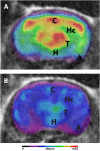18F-FDG-PET in Mouse Models of Alzheimer's Disease
- PMID: 31058151
- PMCID: PMC6482246
- DOI: 10.3389/fmed.2019.00071
18F-FDG-PET in Mouse Models of Alzheimer's Disease
Abstract
Suitable animal models and in vivo biomarkers are essential for development and evaluation of new therapeutic strategies in Alzheimer's disease (AD). 18F-Fluorodeoxyglucose (18F-FDG)-positron-emission tomography (PET) is an imaging biomarker that allows the assessment of cerebral glucose metabolism in vivo. While 18F-FDG-PET/CT is an established tool in the evaluation of AD patients, its role in preclinical studies with AD mouse models remains unclear. Here, we want to review available studies on 18F-FDG-PET/CT in AD mouse models in order to evaluate the method and its impact in preclinical AD research. Only a limited number of studies using 18F-FDG-PET in AD mice were carried out so far showing contradictory findings in cerebral FDG uptake. Methodological differences as well as underlying pathological features of used mouse models seem to be accountable for those varying results. However, 18F-FDG-PET can be a valuable tool in longitudinal in vivo therapy monitoring with a lot of potential for future studies.
Keywords: 18F-FDG-PET; APP; Alzheimer's disease; PET; mouse model; presenilin.
Figures

References
-
- Sasaki A, Shoji M, Harigaya Y, Kawarabayashi T, Ikeda M, Naito M, et al. . Amyloid cored plaques in Tg2576 transgenic mice are characterized by giant plaques, slightly activated microglia, and the lack of paired helical filament-typed, dystrophic neurites. Virchows Arch. (2002) 441:358–67. 10.1007/s00428-002-0643-8 - DOI - PubMed
Publication types
LinkOut - more resources
Full Text Sources

